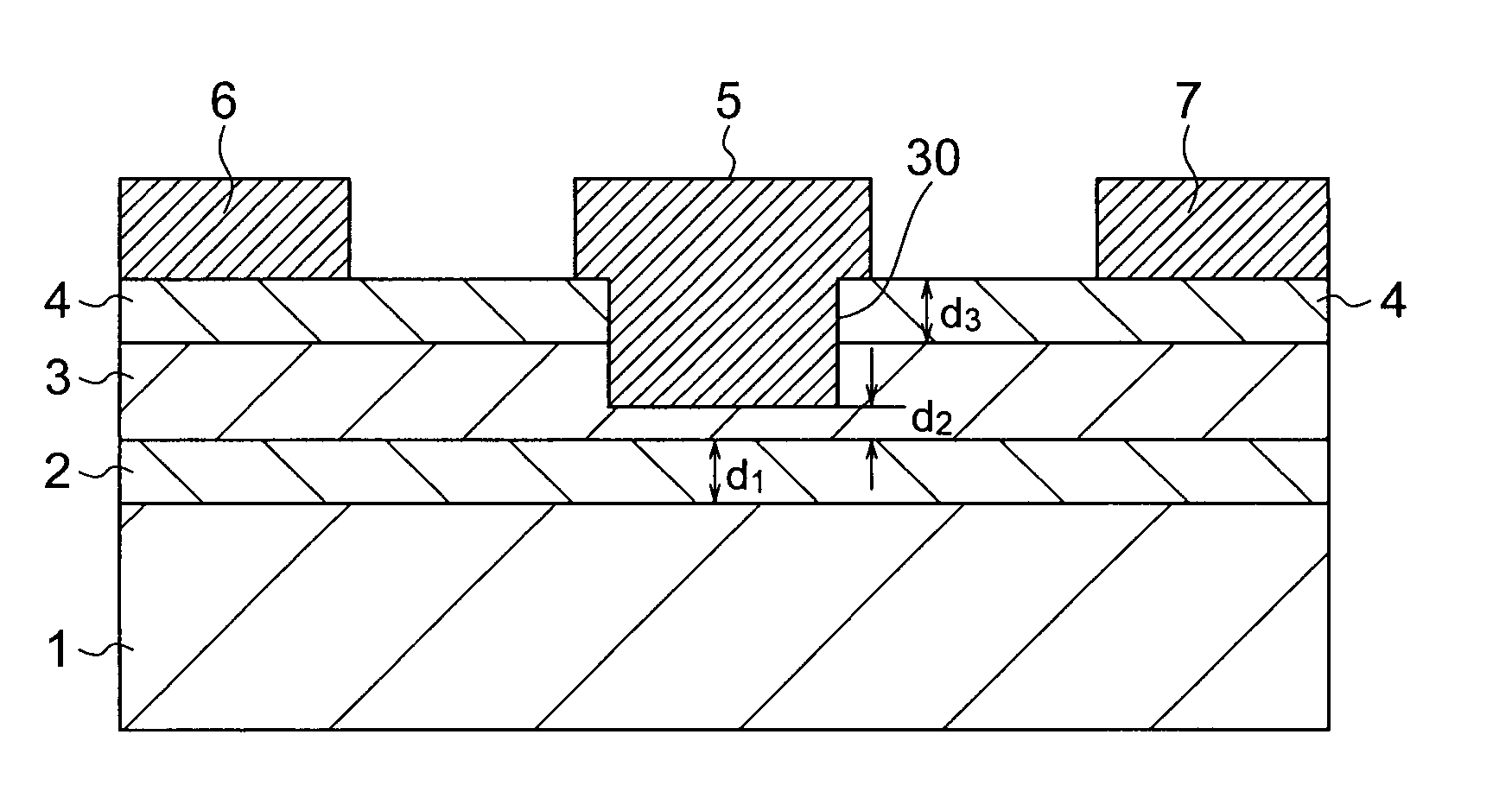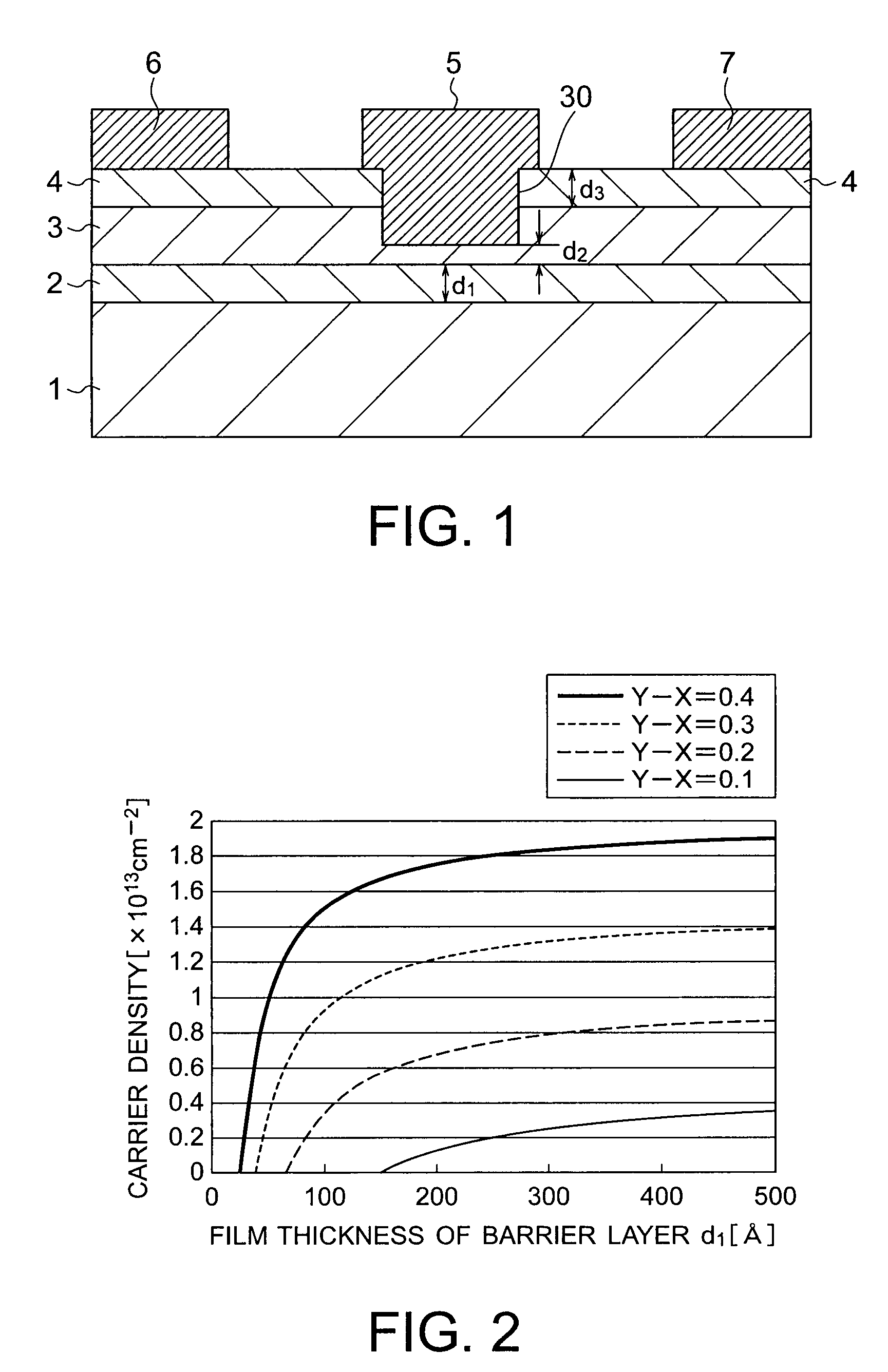Nitride semiconductor device
- Summary
- Abstract
- Description
- Claims
- Application Information
AI Technical Summary
Benefits of technology
Problems solved by technology
Method used
Image
Examples
first embodiment
[0065]FIG. 1 is a sectional view schematically showing a structure of a nitride semiconductor device according to a first embodiment of the present invention. The nitride semiconductor device has a configuration obtained by successively stacking a carrier transit layer 1 formed of a non-doped nitride semiconductor AlXGa1-XN (0≦X2 formed of a non-doped or n-type nitride semiconductor AlYGa1-YN (01, a threshold control layer 3 formed of a non-doped or n-type nitride semiconductor having a lattice constant equal to that of the carrier transit layer 1, and a carrier induction layer 4 formed of InWAlZGa1-W-ZN (05 is formed, a recess structure 30 is formed by removing the whole of the carrier induction layer 4 and a part of the threshold control layer 3. A gate electrode 5 is formed so as to cover the recess structure 30. A source electrode 6 and a drain electrode 7 are formed in substantially symmetrical positions on the carrier induction layer 4 with the gate electrode 5 between. In FIG...
first modification
(First Modification)
[0092] A nitride semiconductor device according to a first modification of the present embodiment is shown in FIG. 13. The nitride semiconductor device according to the modification differs from that according to the first embodiment shown in FIG. 1 in that the gate electrode 5 is formed on the threshold control layer 3, but the gate electrode 5 is not in contact with the carrier induction layer 4. In the case where the whole of the recess structure is filled with the gate electrode 5 as in the first embodiment shown in FIG. 1, an unexpected gap is caused between the gate electrode 5 and the carrier induction layer 4 in some cases. On the other hand, in the present modification, it becomes possible to fabricate the nitride semiconductor device with a high yield by previously keeping the gate electrode 5 apart from the carrier induction layer 4. It is sufficient that a part of the gate electrode 5 is thus formed on the threshold control layer 3 and the shape of th...
second embodiment
[0096] A nitride semiconductor device according to a second embodiment of the present invention is shown in FIG. 16. The nitride semiconductor device according to the present embodiment has a configuration obtained from the first embodiment shown in FIG. 1 by providing an insulation film 8 so as to cover the carrier induction layer 4, the gate electrode 5, the source electrode 6 and the drain electrode 7 and providing a field plate electrode 9 on the insulation film 8 so as to overlap the gate electrode 5, the source electrode 6, and the carrier induction layer 4 between the gate electrode 5 and the source electrode 6.
[0097] The field plate electrode 9 is formed to extend from its first end on the insulation film 8 on a side having the source electrode 6 under, to its second end A located on the drain electrode 7 side as compared with an end B of the gate electrode 5 on the carrier induction layer 4 on the drain electrode 7 side (the right side in FIG. 16). In FIG. 16, the first en...
PUM
 Login to View More
Login to View More Abstract
Description
Claims
Application Information
 Login to View More
Login to View More - R&D
- Intellectual Property
- Life Sciences
- Materials
- Tech Scout
- Unparalleled Data Quality
- Higher Quality Content
- 60% Fewer Hallucinations
Browse by: Latest US Patents, China's latest patents, Technical Efficacy Thesaurus, Application Domain, Technology Topic, Popular Technical Reports.
© 2025 PatSnap. All rights reserved.Legal|Privacy policy|Modern Slavery Act Transparency Statement|Sitemap|About US| Contact US: help@patsnap.com



